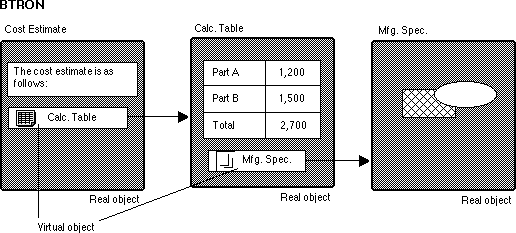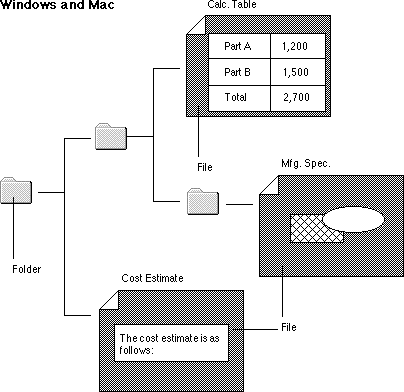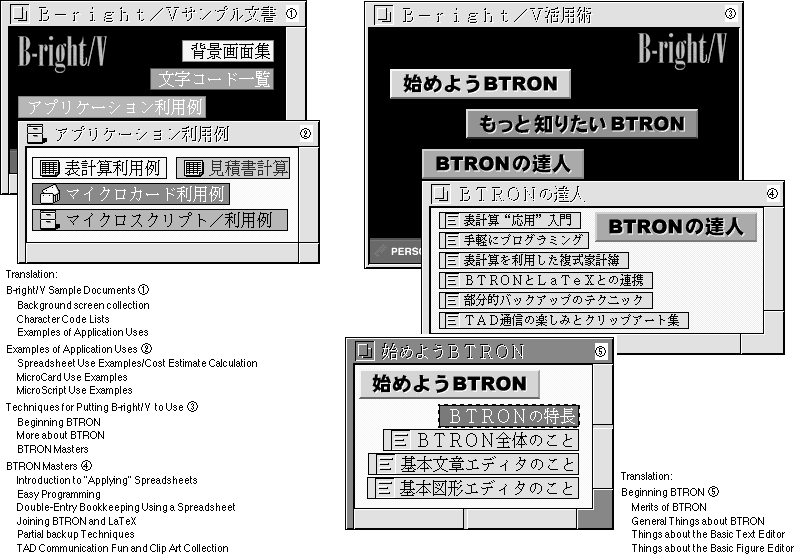

We will briefly explain all the software that B-right/V possesses. All of these are also included in the B-right/V demo version [on the CD-ROM attached to the back Vol. 53 of TRONWARE ].
In B-right/V software is broadly classified into two types: applications and accessories. Applications are software that possesses real objects that become objects of processing. Examples of these are the text editor, spreadsheet, database, and so on. On the other hand, accessories do not possess real objects that become objects of processing. Examples of these are the backup accessory and the calculator accessory. They are things that correspond to so-called utility software.
Let's explain the two words virtual object and real object that are used in BTRON.
A "virtual object" is a thing shaped like a tanzaku paper strip for writing poems. A virtual object points to a real object. When you double click a virtual object the contents of the real object open in a window. It would be all right to think of it as something corresponding to an icon in [Microsoft Corp.'s] Windows or [Apple Computer Inc.'s] Macintosh.
A "real object" is the actual body of the document. This is a "file" in in Windows and Macintosh.
B-right/V's forte is that it can mix virtual objects pointing to other real objects inside the real objects of text, figures [graphics], spreadsheets, and databases. A real object is not merely simple text or figure data, so please pay attention to the point that it becomes a place for storing another real object. This is a point that greatly differs with Windows or Macintosh. In Windows or Macintosh, it is impossible to place files anywhere but in places called a folders, which form trees. In other words, it is impossible to bury an icon representing a document inside a [Microsoft] Word or Excel file. That is something that can be done with B-right/V.
Also, it is also possible to create multiple virtual objects that point to one and the same real object (using the operation to reproduce a virtual object). In that sense, a virtual object corresponds to a Windows shortcut or a Macintosh alias.
We call real objects and virtual objects bound together into a net form "a real object/ virtual object network."


In the BTRON-specification operating system (OS), a standard data format called TAD (TRON Application Data-bus) is prescribed. B-right/V, of course, also complies with this. What TAD specifies is not merely simple character codes or image formats (for paint-type data). Text form data and segment graphics data (for draw-type data) also become objects of specification. For that reason, the extent to which data can be reused among applications is high, and data processing in which various applications are organically merged becomes possible.
Many sample documents of various types are included in B-right/V (exactly the same types are also in the B-right/V demo version). In particular, there are lots of helpful hints in "Examples of Application Uses" inside "B-right/V Sample Documents," and in "Beginning BTRON" and "BTRON Masters" inside "Techniques for Putting B-right/V to Use." Please take a look at them.

B-right is a registered trademark of Personal Media Corporation
The above information appeared in the article "B-right/V Quick Reference" on pages 36-45 of Vol. 53 of TRONWARE . It was translated and loaded onto this web page with the permission of Personal Media Corporation.
Copyright © 1998 Personal Media Corporation
Copyright © 1998 Sakamura Laboratory, University Museum, University of Tokyo